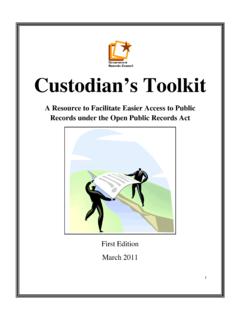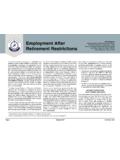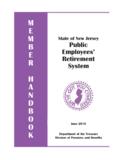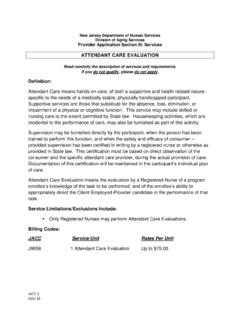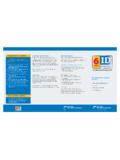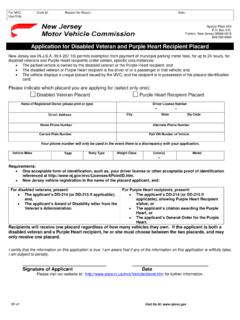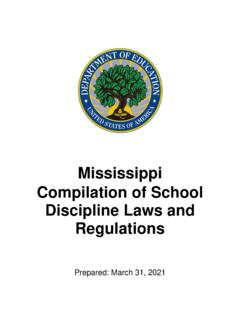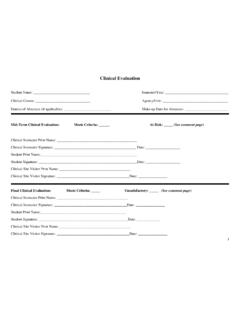Transcription of Public Health Recommendations for Implementing COVID-19 ...
1 1 Public Health Recommendations for Implementing COVID-19 Screening Testing in K- 12 Schools Updated March 16, 2022 Overview: Viral testing strategies in schools are part of a comprehensive prevention approach. Testing should not be used alone, but in combination with other prevention strategies to reduce the risk of SARS-CoV-2 transmission in schools. When schools implement testing combined with prevention strategies, they can detect new cases to prevent outbreaks, reduce the risk of further transmission, and protect students, teachers, and staff from COVID-19 . Testing strategies can be broadly divided into diagnostic testing, which evaluates symptomatic individuals or individuals who have been exposed to COVID-19 , and screening testing, in which entire groups or cohorts of asymptomatic cases are tested.
2 All K-12 schools should have a plan to provide or refer students and staff for diagnostic testing and are strongly encouraged to develop a screening testing strategy to identify asymptomatic infections to prevent further transmission in school. The below Recommendations are intended to provide guidelines for K-12 schools for Implementing screening testing for students and staff. All testing strategies in K-12 schools should be developed in consultation with local Health departments. Types of Screening Tests Viral tests (molecular or antigen) should be used for screening testing in K-12 schools. When considering which test or tests to use for screening testing, schools or their testing partners should choose those that can be reliably supplied and that provide results within 24-48 hours.
3 Molecular Tests Molecular tests, which include nucleic acid amplification tests (NAAT) such as RT-PCR, are highly accurate viral tests for the virus that causes COVID-19 . Most molecular tests need to be processed in a laboratory where results may take up to 1-3 days, but some molecular tests can be performed at or near the point-of -care with results available in about 15 minutes. Antigen Tests Antigen tests are less sensitive than molecular tests, but most carry the advantage of rapid processing at the point-of -care with results available in about 15 minutes. Antigen test results might need confirmation with a molecular test in certain circumstances, such as a negative test in persons with symptoms or a positive test in persons without symptoms.
4 Schools should work with Public Health agencies to develop a confirmation and referral plan before Implementing antigen testing. Antigen tests can be used for screening testing in schools. The immediacy of results (test results in 15 30 minutes), modest costs, and feasibility of implementation of antigen testing make them a reasonable option for school-based screening testing. 2 Collection Methods Different platforms of molecular and antigen tests may rely on different collection methods ( , nasal swabs, nasopharyngeal swabs, saliva samples). The feasibility and acceptability of tests that use nasal (anterior nares) swabs make these types of tests more readily implemented in school settings, although tests that use saliva specimens might also be acceptable alternatives for younger children.
5 Pooled Testing Schools may consider using pooled testing as a screening testing strategy for students. Pooled testing involves mixing several samples from different individuals together in a batch or pooled sample, then testing the pooled sample with a diagnostic test. This approach increases the number of individuals that can be tested and reduces the need for testing resources. This approach may be particularly helpful in schools using cohorts. Because of the complexities of acting on a positive result, pooled testing is best used in situations where the number of positives is expected to be very low. NJDOH strongly recommends that schools considering pooled testing ensure that the performing laboratory can test to the individual level should the pool be positive BEFORE contracting with that laboratory for screening testing services.
6 Pooled testing may reduce costs and may be considered for at least weekly screening testing in areas of low (green) and moderate (yellow) community transmission and may be particularly helpful in schools using cohorts. Schools considering pooled testing must ensure that the performing laboratory can test to the individual level within 24-48 hours should the pool be positive. Home-based testing A variety of home-based COVID-19 tests are becoming more widely available. While all involve self-collection of specimens, some test kits require a prescription and others are over-the-counter (OTC). Some collections/testing are observed by a telehealth provider, some involve self-collection but are sent to a laboratory for processing, and others use self-collection and self-testing without any involvement of a healthcare provider.
7 Some home-based tests have been authorized by FDA for screening purposes, ot hers for diagnostic testing. Information on how home-based testing may be applicable in K-12 schools can be found at More information on self-testing is available at Requirements for Screening Testing: Screening testing strategies should be developed in conjunction with Public Health agencies and should be part of a comprehensive prevention approach. Mechanism to obtain parental consent for minor students and assent/consent from the students themselves. 3 o Testing should be offered on a voluntary basis. o School-based testing should NEVER be conducted without consent from a parent or legal guardian (for minor students) or from the individual him or herself (for adults).
8 It is not recommended to retest individuals who have tested positive and do not have symptoms for COVID-19 for up to 3 months from their last positive test. All screening tests should be authorized by FDA for the specific intended use ( , screening, pooling), and a mechanism in place for test orders by a licensed Health care provider. Clinical Laboratory Improvement Amendments (CLIA) certificate of waiver requirements to perform school-based testing with EUA authorized tests. School nurses may perform COVID-19 point-of -care testing if they receive a CLIA certificate of waiver or are functioning under a CLIA certificate of waiver of another organization. Mechanism to report all testing results to Public Health authorities as required by the NJDOH.
9 Physical space to conduct testing safely and privately ( , gymnasium, auditorium). Access to and training on the proper use of personal protective equipment (PPE) for persons conducting screening testing. Ability to maintain confidentiality of results and protect student privacy. Plans for ensuring access to confirmatory testing when needed (asymptomatic persons who receive a positive test result). See NJDOH Recommendations below. Not every school will have sufficient staff, resources, or training to conduct testing. However, the US Department of Health and Human Services (HHS) and CDC have made available a grant program to assist schools with screening testing. Participation in this program is voluntary but strongly encouraged.
10 More information can be found in this Memo to Schools. LEAs and nonpublic schools interested in participating in this program can obtain additional information by emailing Interpreting/ reporting Screening Test Results: All test results should be reported to Public Health agencies. In addition, individuals who test positive by any testing modality should follow NJDOH exclusion guidance. In all circumstances, after receiving the results of a positive test: The individual should be immediately excluded from school. School-based close contacts should be identified and excluded from school for 10 days (regional risk green/yellow) or 14 days (regional risk orange/red). Individuals who test positive by rapid antigen test and who are asymptomatic should be additionally referred for confirmatory testing by a molecular test (for example, RT-PCR) with specimen collection within 2 days of initial specimen.
